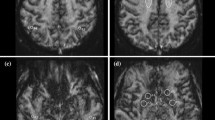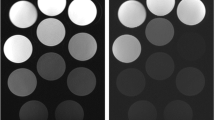Abstract
Purpose
To compare the effectiveness of silent susceptibility-weighted angiography (sSWAN), a new imaging technique with lower acoustic noise, with conventional susceptibility-weighted angiography (cSWAN) in the detection of intracranial hemorrhagic lesions.
Methods
We measured the acoustic and background noise during sSWAN and cSWAN imaging and calculated the contrast-to-noise ratio (CNR) of the phantom consisting of eight chambers with different concentrations of superparamagnetic iron oxide. In the clinical study, we calculated the CNRs of hemorrhagic lesions in 15 patients and evaluated the images for conspicuity and artifact on each sequence and scored them on a 4-point scale. We also evaluated whether hypointense areas observed on sSWAN or cSWAN increased in size from those on T2*-weighted imaging (T2*-WI).
Results
Acoustic noise for sSWAN (57.9 ± 0.32 dB [background noise 51.3 dB]) was significantly less than that for cSWAN (89.0 ± 0.22 dB [background noise 50.9 dB]). The CNRs of phantoms for sSWAN were slightly but not significantly lower than those for cSWAN (P = 0.18). The CNRs of hemorrhagic lesions did not show significant differences between sSWAN and cSWAN (P = 0.17). There were no significant differences between sSWAN and cSWAN with respect to the scores for conspicuity, artifact, and change in size of hypointense areas from T2*-WI.
Conclusion
sSWAN is equivalent to cSWAN with respect to the image quality for the detection of hemorrhagic lesions but has lower acoustic noise.




Similar content being viewed by others
References
Quirk ME, Letendre AJ, Ciottone RA, Lingley JF (1989) Anxiety in patients undergoing MR imaging. Radiology 170(2):463–466. https://doi.org/10.1148/radiology.170.2.2911670
Brummett RE, Talbot JM, Charuhas P (1988) Potential hearing loss resulting from MR imaging. Radiology 169(2):539–540. https://doi.org/10.1148/radiology.169.2.3175004
McJury M, Shellock FG (2000) Auditory noise associated with MR procedures: a review. J Magn Reson Imaging 12(1):37–45
Jin C, Li H, Li X et al (2018) Temporary hearing threshold shift in healthy volunteers with hearing protection caused by acoustic noise exposure during 3-T multisequence MR neuroimaging. Radiology 286(2):602–608. https://doi.org/10.1148/radiol.2017161622
Edwards AD, Arthurs OJ (2011) Paediatric MRI under sedation: is it necessary? What is the evidence for the alternatives? Pediatr Radiol 41(11):1353–1364. https://doi.org/10.1007/s00247-011-2147-7
Barkovich MJ, Xu D, Desikan RS, Williams C, Barkovich AJ (2018) Pediatric neuro MRI: tricks to minimize sedation. Pediatr Radiol 48(1):50–55. https://doi.org/10.1007/s00247-017-3785-1
Katsunuma A, Takamori H, Sakakura Y, Hamamura Y, Ogo Y, Katayama R (2002) Quiet MRI with novel acoustic noise reduction. MAGMA 13(3):139–144. https://doi.org/10.1016/S1352-8661(01)00142-9
Alibek S, Vogel M, Sun W et al (2014) Acoustic noise reduction in MRI using Silent Scan: an initial experience. Diagn Interv Radiol 20(4):360–363. https://doi.org/10.5152/dir.2014.13458
Corcuera-Solano I, Doshi A, Pawha PS, Gui D, Gaddipati A, Tanenbaum L (2015) Quiet PROPELLER MRI techniques match the quality of conventional PROPELLER brain imaging techniques. AJNR Am J Neuroradiol. 36(6):1124–1127. https://doi.org/10.3174/ajnr.A4235
Heismann B, Ott M, Grodzki D (2015) Sequence-based acoustic noise reduction of clinical MRI scans. Magn Reson Med 73(3):1104–1109. https://doi.org/10.1002/mrm.25229
Rösch J, Ott M, Heismann B et al (2016) Quiet diffusion-weighted head scanning: initial clinical evaluation in ischemic stroke patients at 1.5T. J Magn Reson Imaging 44(5):1238–1243. https://doi.org/10.1002/jmri.25228
Hayashida Y, Kakeda S, Hiai Y et al (2014) Diagnosis of intracranial hemorrhagic lesions: comparison between 3D-SWAN (3D T2*-weighted imaging with multi-echo acquisition) and 2D-T2*-weighted imaging. Acta Radiol 55(2):201–207. https://doi.org/10.1177/0284185113495836
Mori N, Miki Y, Kikuta K et al (2008) Microbleeds in moyamoya disease: susceptibility-weighted imaging versus T2*-weighted imaging at 3 Tesla. Invest Radiol 43(8):574–579. https://doi.org/10.1097/RLI.0b013e31817fb432
de Souza JM, Domingues RC, Cruz LC Jr, Domingues FS, Iasbeck T, Gasparetto EL (2008) Susceptibility-weighted imaging for the evaluation of patients with familial cerebral cavernous malformations: a comparison with T2-weighted fast spin-echo and gradient-echo sequences. AJNR Am J Neuroradiol 29(1):154–158. https://doi.org/10.3174/ajnr.A0748
Worters PW, Beque D, Peters RD et al (2016) Quantitative susceptibility mapping-comparison of silent and conventional acquisitions proc. Intl. Soc. Mag. Reson. Med 24:4099
Akter M, Hirai T, Hiai Y et al (2007) Detection of hemorrhagic hypointense foci in the brain on susceptibility-weighted imaging clinical and phantom studies. Acad Radiol 14(9):1011–1019. https://doi.org/10.1016/j.acra.2007.05.013
Aida N, Niwa T, Fujii Y et al (2016) Quiet T1-weighted pointwise encoding time reduction with radial acquisition for assessing myelination in the pediatric brain. AJNR Am J Neuroradiol 37(8):1528–1534. https://doi.org/10.3174/ajnr.A4747
Matsuo-Hagiyama C, Watanabe Y, Tanaka H et al (2017) Comparison of silent and conventional MR imaging for the evaluation of myelination in children. Magn Reson Med Sci 16(3):209–216. https://doi.org/10.2463/mrms.mp.2016-0045
Ohlmann-Knafo S, Morlo M, Tarnoki DL et al (2016) Comparison of image quality characteristics on silent MR versus conventional MR imaging of brain lesions at 3 Tesla. Br J Radiol 89(1067):20150801. https://doi.org/10.1259/bjr.20150801
Tong KA, Ashwal S, Obenaus A, Nickerson JP, Kido D, Haacke EM (2008) Susceptibility-weighted MR imaging: a review of clinical applications in children. AJNR Am J Neuroradiol 29(1):9–17. https://doi.org/10.3174/ajnr.A0786
Funding
None
Author information
Authors and Affiliations
Corresponding author
Ethics declarations
Conflict of interest
The authors declare that they have no conflict of interest.
Ethical approval
All procedures performed in studies involving human participants were in accordance with the ethical standards of the institutional and/or national research committee and with the 1964 Helsinki declaration and its later amendments or comparable ethical standards.
Informed consent
Informed consent was obtained from all individual participants included in the study.
Additional information
Publisher’s note
Springer Nature remains neutral with regard to jurisdictional claims in published maps and institutional affiliations.
Rights and permissions
About this article
Cite this article
Fujiwara, T., Watanabe, Y., Tanaka, H. et al. Silent susceptibility-weighted angiography to detect hemorrhagic lesions in the brain: a clinical and phantom study. Neuroradiology 62, 205–209 (2020). https://doi.org/10.1007/s00234-019-02296-9
Received:
Accepted:
Published:
Issue Date:
DOI: https://doi.org/10.1007/s00234-019-02296-9




